
Looking for How to Make Home-Canned Pickled Three-Bean Salad - Easily! With Step-by-step Directions, Photos, Ingredients, Recipe and Costs in 2025? Scroll down this page and follow the links. And if you bring home some fruit or vegetables and want to can, freeze, make jam, salsa or pickles, see this page for simple, reliable, illustrated canning, freezing or preserving directions. There are plenty of other related resources, click on the resources dropdown above. If you are having a hard time finding canning lids, I've used these, and they're a great price & ship in 2 days.
If you have questions or feedback, please let me know! There are affiliate links on this page. Read our disclosure policy to learn more.
How to Make Home-Canned Pickled Three-Bean Salad - Easily! With Step-by-step Directions, Photos, Ingredients, Recipe and Costs
Yield: 5 to 6 half pint jars
Click here for a PDF print version
Making and canning your own Pickled Three-Bean Salad is easy with this recipe! You can use an ordinary water bath canner to "can" it, or refrigerate it to eat fresh.
Ingredients
- 11/2 cups cut and blanched green or yellow beans (prepared as below)
- 11/2 cups canned, drained, red kidney beans
- 1 cup canned, drained garbanzo beans (also called "chick peas")
- 1/2 cup peeled and thinly sliced onion (about 1 medium onion)
- 1/2 cup trimmed and thinly sliced celery (11/2 medium stalks)
- 1/2 cup sliced green peppers (or 1/2 medium pepper)
- 1/2 cup white vinegar (5 percent acidity)
- 1/4 cup bottled lemon juice
- 3/4 cup sugar
- 1/4 cup oil
- 1/2 teaspoon canning or pickling salt
- 11/4 cups water
Equipment
- 1 Water Bath Canner (a huge pot to sanitize the jars after filling (about $30 to $35 at mall kitchen stores, sometimes at big box stores and grocery stores.). Note: we sell many sizes and types of canners for all types of stoves and needs - see canning supplies
- Pint canning jars (Ball or Kerr jars can be found at grocery stores, like Safeway, Publix, Kroger, grocery stores, even online - about $13 per dozen 8-ounce jars, more for quilted design or larger jars, including the lids and rings). Be sure to get wide mouth jars to fit the pickles in! Pint size works best!
- Lids - thin, flat, round metal lids with a gum binder that seals them against the top of the jar. They may only be used once.
- Rings - metal bands that secure the lids to the jars. They may be reused many times.
- Jar grabber (to pick up the hot jars)
- Lid lifter (I like the lid rack that holds 12 lids or you can pull them out one at a time with the lid-lifter that has a magnet from the almost-boiling water where you sanitize them. ($4 at Target, other big box stores, and often grocery stores; and available online - see this page)
- Jar funnel ($5 at Target, other big box stores, and often grocery stores; and available online - see this page)
- 1 large pot; Nonstick ceramic coated pots for easy cleanup.
- Large spoons and ladles,
Pickled Three-Bean Salad Directions - Step by Step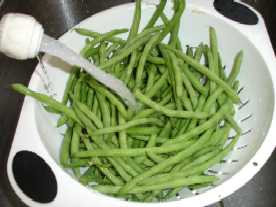
Step 1 - Wash the fresh green beans.
Wash the beans under cool running water.
Step 2 - Trim the ends
Just take a sharp knife and cut of both ends (about 1/4 of an i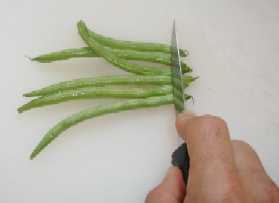 nch, or
half the width of an average woman's little finger). Then cut them
into pieces of the size you prefer, usually about 1 inch long.
nch, or
half the width of an average woman's little finger). Then cut them
into pieces of the size you prefer, usually about 1 inch long.
Of
course, if your prefer French cut green beans, you can cut the beans
lengthwise instead, or you can use a "bean Frencher" (No, that does not
make the beans want to wear a beret, "mime" or surrender quickly, it's just the name..
). The "Frencher" enables you to prepare a huge quantity of beans
quickly!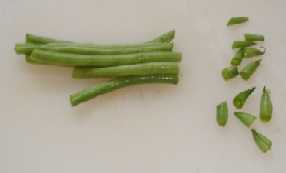
See the bottom of this page for makes, models, prices and ordering info for bean frenchers.
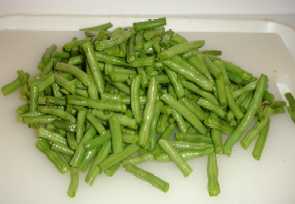
Pickle Making Problems? Pickling FAQs Frequently asked questions and answers
Norpro Deluxe Bean Frencher With Clamp
Norpro White French Bean Slicer
Fermentation Jars (2 pack), 2 Liter Fermentation Kit with Weights and Airlocks
In the UK, use this link:
Click here for related items on Amazon
Step 3 - Blanch the green beans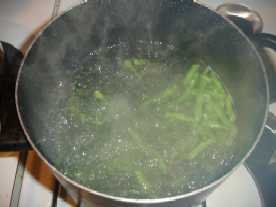
All fruits and vegetables contain enzymes and bacteria that, over time, break down the destroy nutrients and change the color, flavor, and texture of food during frozen storage. green beans requires a brief heat treatment, called blanching, in boiling water or steam, to destroy the enzymes before freezing. Blanching times for beans is 3 minutes (the duration should be just long enough to stop the action of the enzymes and kill the bacteria).
Begin counting the blanching time as soon as you place the green beans in the boiling water. Cover the kettle and boil at a high temperature for the required length of time. You may use the same blanching water several times (up to 5). Be sure to add more hot water from the tap from time to time to keep the water level at the required height.
Step 4 - Cool the green beans
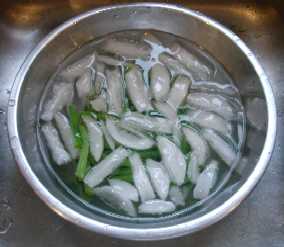 Cool green beans immediately in ice water. Drain
the green beans thoroughly (this shouldn't take more than a minute).
Cool green beans immediately in ice water. Drain
the green beans thoroughly (this shouldn't take more than a minute).
After vegetables are blanched, cool them quickly to prevent overcooking. Plunge the green beans into a large quantity of ice-cold water (I keep adding more ice to it). A good rule of thumb: Cool for the same amount of time as the blanch step. For instance, if you blanch sweet green beans for 7 minutes, then cool in ice water for 7 minutes.
Drain thoroughly.
Step 5 - Rinse the Kidney beans
Rinse the kidney beans with tap water and drain again.
Step 6 - Slice the other vegetables
Prepare and measure:
- 1/2 cup peeled and thinly sliced onion (about 1 medium onion)
- 1/2 cup trimmed and thinly sliced celery (11/2 medium stalks)
- 1/2 cup sliced green peppers (or 1/2 medium pepper)
Step 7 - Make the pickling solution
Combine
- 1/2 cup white vinegar (5 percent acidity)
- 1/4 cup bottled lemon juice
- 3/4 cup sugar
- 11/4 cups water
in a pot and bring to a boil. Remove from heat.
Add
- 1/4 cup oil
- 1/2 teaspoon canning or pickling salt
Step 8 - Add the beans
Add the beans, onions, celery and green pepper to solution and bring to a simmer.
Step 9 - Cool to room temperature and refrigerate
Let the mix cool to room temperature (about 1 hour) then refrigerate to allow it to marinate for 12 to 14 hours.
Step 10 - Reheat the mix
Heat entire mixture to a boil. Get the canner heating and make sure your jars are clean (they need not be sterile, as the canner will do that).
Step 11 - Fill the jars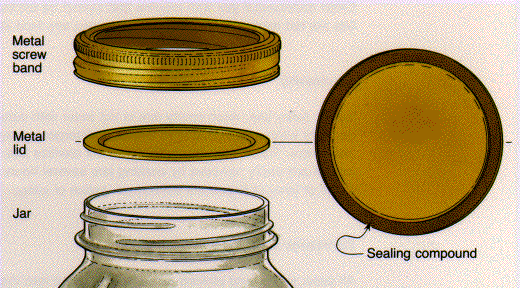
Fill clean, hot jars with solids. Add hot liquid, leaving 1/2-inch headspace. Remove air bubbles. Wipe jar rims. Adjust lids.

Step
12 - Put the jars in the canner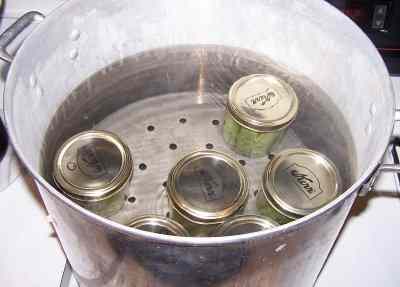
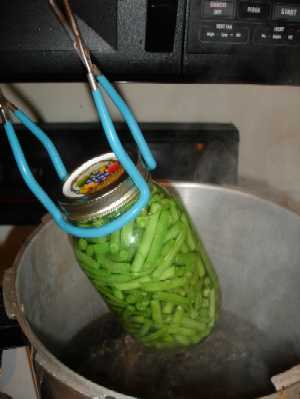 Using
the jar tongs, put the pint jars
in the canner and keep them covered with at least 1 inch of water. Keep
the water
boiling. Boil them for 15 minutes.
Using
the jar tongs, put the pint jars
in the canner and keep them covered with at least 1 inch of water. Keep
the water
boiling. Boil them for 15 minutes.
Remember to adjust for altitudes and larger jars - see the table below!
|
Recommended process time for Pickled Three-Bean Salad in a boiling water canner, hot pack. Process Time at Altitudes of |
|||
| Jar Size | 0-1,000 ft | 1,001 - 6,000 ft | Above 6,000 ft |
| Half-pints or Pints | 15 min | 20 | <25 |
Step 13 - Done
Lift the jars out of the water and let them cool without touching or bumping them in a draft-free place (usually takes overnight) You can then remove the rings if you like, but if you leave them on, at least loosen them quite a bit, so they don't rust in place due to trapped moisture. Once the jars are cool, you can check that they are sealed verifying that the lid has been sucked down. Just press in the center, gently, with your finger. If it pops up and down (often making a popping sound), it is not sealed. If you put the jar in the refrigerator right away, you can still use it. Some people replace the lid and reprocess the jar, then that's a bit iffy. If you heat the contents back up, re-jar them (with a new lid) and the full time in the canner, it's usually ok.
When can you start eating the beans? Well, it takes some time for the seasonings to be absorbed into the pickles. Generally, that's about 2 or 3 days! Ah... the wait...
This document was adapted from the "Complete Guide to Home Canning,"
Agriculture Information Bulletin No. 539, USDA, revised 2006.
Reviewed May 2009.
Canning Books, Supplies and Accessories
These are my favorite essential canning tools, books and supplies. I've been using many of these for over 50 years of canning! The ones below on this page are just the sampling of. my preferred tools. but you can find much more detailed and extensive selections on the pages that are linked below.
- Vacuum Foodsealers for freezing, dried foods, and refrigerated foods - the FoodSaver line
- Selecting a KitchenAid mixer and attachments for home canning
- Steam Juicers
- Strainers, pit removers, seed-skin-stem removers, jelly strainers, etc. All types, makes and prices (from $19 to $350)
- Cherry pitters reviews, prices and ordering
- Food dehydrators - easy and fast to dry your own fruits, veggies, sun-dried tomatoes, etc.
The All New Ball Book Of Canning And Preserving: Over 350 of the Best Canned, Jammed, Pickled, and Preserved Recipes Paperback
This is THE book on canning! My grandmother used this book when I was a child.; It tells you in simple instructions how to can almost anything; complete with recipes for jam, jellies, pickles, sauces, canning vegetables, meats, etc.
If it can be canned, this book likely tells you how! Click on the link below for more information and / or to buy (no obligation to buy)The New Ball Blue Book of Canning and Preserving
Canning and Preserving for Dummies by Karen Ward
This is another popular canning book. Click here for more information, reviews, prices for Canning and Preserving For Dummies
Of course, you do not need to buy ANY canning book as I have about 500 canning, freezing, dehydrating and more recipes all online for free, just see Easy Home Canning Directions.
Home Canning Kits
See here for related tools, equipment, supplies on Amazon See here for related tools, equipment, supplies on Amazon
I have several canners, and my favorite is the stainless steel one at right. It is easy to clean and seems like it will last forever. Mine is 10 years old and looks like new.
The black ones are the same type of standard canner that my grandmother used to make everything from applesauce to jams and jellies to tomato and spaghetti sauce.
This complete kit includes everything you need and lasts for years: the canner, jar rack, Jar grabber tongs, lid lifting wand, a plastic funnel, labels, bubble freer, It's much cheaper than buying the items separately. It's only missing the bible of canning, the Ball Blue Book.
You will never need anything else except jars & lids (and the jars are reusable)!
The complete list of canners is on these pages:
- Water bath canners - Good for acidic foods, like applesauce, pickles, salsa, jams, jellies, most fruits
- Pressure canners - needed for low and non-acidic foods, like canned vegetables (corn, green beans, etc), and meats
- Canners for glass top stoves if you have a glass or ceramic stove
- Canners for induction stovetops
Pressure Canners
If you plan on canning non-acidic foods and low acid foods that are not pickled - this means: meats, seafood, soups, green beans corn, most vegetables, etc., then you ABSOLUTELY must use a Pressure Canner.
Of course, you can use a pressure canner as a water bath canner as well - just don't seal it up, so it does not pressurize. This means a Pressure Canner is a 2-in-1 device. With it, you can can almost ANYTHING.
There are also other supplies, accessories, tools and more canners, of different styles, makes and prices, click here!
Basic Canning Accessories
From left to right:
- Jar lifting tongs to pick up hot jars
- Lid lifter - to remove lids from the pot of boiling water (sterilizing )
- Lids- disposable - you may only use them once
- Ring - holds the lids on the jar until after the jars cool - then you remove them, save them and reuse them
- Canning Jar funnel - to fill the jars
FREE Illustrated Canning, Freezing, Jam Instructions and Recipes
Don't spend money on books. that you don't need to. Almost everything you can find in some book sold online or in a store is on my website here for free. Start with theEasy Home Canning Directions below. That is a master list of canning directions which are all based upon the Ball Bblue book, the National Center for Home Food Preservation and other reputable lab tested recipes. Almost every recipe I present in addition to being lab tested com. is in a step by step format with photos for each step and complete. explanations. that tell you how to do it, where to get the supplies and pretty much everything you need to know. In addition, there almost always in a PDF format so you can print them out and use them while you cook.
[ Easy Home Canning Directions]
[FAQs - Answers to common questions and problems]
[Recommended books about home canning, jam making, drying and preserving!]
Looking for canning equipment and supplies?
Water bath canner with a jar rack
Pressure canners for gas, electric and induction stoves: Presto 23Qt or T-fal 22Qt
Canning scoop (this one is PERFECT)
Ball Blue book (most recent version)
Jars: 8oz canning jars for jams
Find Other types of farms:
Farm markets and roadside stands
Road trips and camping resources
Local Honey, apiaries, beekeepers
Consumer fraud and scams information
Home canning supplies at the best prices on the internet!
Maple Syrup Farms, sugarworks, maple syrup festivals
Environmental information and resources
Farms For Your Event for birthday parties, weddings, receptions, business meetings, retreats, etc.
Festivals - local fruit and vegetable festivals
Get the
most recent version of
the Ball Blue Book
With this Presto 23 quart pressure canner and pressure cooker, you can "can" everything, fruits, vegetables, jams, jellies, salsa, applesauce, pickles, even meats, soups, stews. Model 01781

You can make jams, jellies, can fruit, applesauce, salsa and pickles with water bath canners, like this Granite Ware 12-Piece Canner Kit, Jar Rack, Blancher, Colander and 5 piece Canning Tool Set



